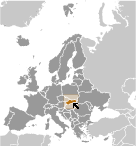World Atlas: Slovakia. On this page you can see the map, country flag and many detailed information about the people, history and economy of Slovakia.

Here you can find online selected information about the geography, inhabitants, government, economy and history of Slovakia. Included are selected statistics, an overview map and the detailed map of Slovakia. But let's start with the flag of Slovakia here:
Slovakia - Overview:
What you should know about Slovakia? Let's start with this: Slovakia traces its roots to the 9th century state of Great Moravia. Subsequently, the Slovaks became part of the Hungarian Kingdom, where they remained for the next 1,000 years. Following the formation of the dual Austro-Hungarian monarchy in 1867, language and education policies favoring the use of Hungarian (Magyarization) resulted in a strengthening of Slovak nationalism and a cultivation of cultural ties with the closely related Czechs, who were under Austrian rule. After the dissolution of the Austro-Hungarian Empire at the close of World War I, the Slovaks joined the Czechs to form Czechoslovakia. During the interwar period, Slovak nationalist leaders pushed for autonomy within Czechoslovakia, and in 1939 Slovakia became an independent state allied with Nazi Germany. Following World War II, Czechoslovakia was reconstituted and came under communist rule within Soviet-dominated Eastern Europe. In 1968, an invasion by Warsaw Pact troops ended the efforts of the country's leaders to liberalize communist rule and create "socialism with a human face," ushering in a period of repression known as "normalization." The peaceful "Velvet Revolution" swept the Communist Party from power at the end of 1989 and inaugurated a return to democratic rule and a market economy. On 1 January 1993, the country underwent a nonviolent "velvet divorce" into its two national components, Slovakia and the Czech Republic. Slovakia joined both NATO and the EU in the spring of 2004 and the euro zone on 1 January 2009.
Geography of Slovakia
 Where on the globe is Slovakia? The location of this country is Central Europe, south of Poland. Total area of Slovakia is 49,035 sq km, of which 48,105 sq km is land. So this is not a large country. How could we describe the terrain of the country? This way: rugged mountains in the central and northern part and lowlands in the south. The lowest point of Slovakia is Bodrok River 94 m, the highest point Gerlachovsky Stit 2,655 m. And the climate is temperate; cool summers; cold, cloudy, humid winters.
Where on the globe is Slovakia? The location of this country is Central Europe, south of Poland. Total area of Slovakia is 49,035 sq km, of which 48,105 sq km is land. So this is not a large country. How could we describe the terrain of the country? This way: rugged mountains in the central and northern part and lowlands in the south. The lowest point of Slovakia is Bodrok River 94 m, the highest point Gerlachovsky Stit 2,655 m. And the climate is temperate; cool summers; cold, cloudy, humid winters.
Inhabitants of Slovakia
Let's take a look how many people live in Slovakia. The number is: 5,445,829 (July 2017 est.). So this is not very populous country. Who lives here? Slovak 80.7%, Hungarian 8.5%, Romani 2%, other and unspecified 8.8% (2011 est.). What are the languages in Slovakia? Slovak (official) 78.6%, Hungarian 9.4%, Roma 2.3%, Ruthenian 1%, other or unspecified 8.8% (2011 est.). And the religions: Roman Catholic 62%, Protestant 8.2%, Greek Catholic 3.8%, other or unspecified 12.5%, none 13.4% (2011 est.). How old are the people in average? 40.5 years. We have to add that this number is the median - so one half of the people is older than this, one half is younger. And what is their life expectancy (at birth)? This: 77.3 years. Where the people live in Slovakia? Here: a fairly even distribution throughout most of the country; slightly larger concentration in the west in proximity to the Czech borde. The major urban areas of Slovakia are: Bratislava (capital) 401,000 (2015).
Government and Economy of Slovakia
The capital of Slovakia is Bratislava and the government type parliamentary republic. Let's take a look at the administrative divisions - 8 regions (kraje, singular - kraj); Banskobystricky, Bratislavsky, Kosicky, Nitriansky, Presovsky, Trenciansky, Trnavsky, Zilinsky. Regarding the economy of Slovakia, important industrial products are automobiles; metal and metal products; electricity, gas, coke, oil, nuclear fuel; chemicals, synthetic fibers, wood and paper products; machinery; earthenware and ceramics; textiles; electrical and optical apparatus; rubber products; food and beverages; pharmaceutical. Important agricultural products are grains, potatoes, sugar beets, hops, fruit; pigs, cattle, poultry; forest products. The most important export commodities are vehicles and related parts 27%, machinery and electrical equipment 20%, nuclear reactors and furnaces 12%, iron and steel 4%, mineral oils and fuels 5% (2015 est.) and the most important export partners are Germany 21.9%, Czech Republic 11.9%, Poland 7.7%, France 6.1%, UK 5.9%, Austria 5.7%, Hungary 5.7%, Italy 4.8% (2016). The most important import commodities are machinery and electrical equipment 20%, vehicles and related parts 14%, nuclear reactors and furnaces 12%, fuel and mineral oils 9% (2015 est.) and the most important import partners are Germany 20.2%, Czech Republic 16.9%, Austria 9.8%, Poland 6.5%, Hungary 6.1%, South Korea 4.7%, China 4.6%, France 4.4% (2016). How rich is Slovakia and how rich are people in this country? The most important number here is GDP per capita (PPP): $32,900 (2017 est.). This means the living standards are good here. Let's add that this means Gross Domestic Product per person, which is recalculated with respect to the relative cost of local goods and services. And one more important number - population below poverty line: 12.3% (2015 est.).